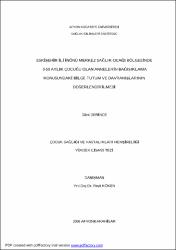Eskişehir İli İnönü Merkez Sağlık Ocağı Bölgesinde 0-59 Aylık Çocuğu Olan Annelerin Bağışıklama Konusundaki Bilgi, Tutum ve Davranışlarının Değerlendirilmesi
Abstract
Bu çalışmada, Eskişehir ili İnönü Merkez Sağlık Ocağı bölgesinde 0-59 aylık
çocuğu olan annelerin bağışıklama konusundaki bilgi, tutum ve davranışlarının
değerlendirilmesi amaçlandı.
Kesitsel tipteki bu araştırma, İl Sağlık Müdürlüğü’nden gerekli izinler
alındıktan sonra İnönü Merkez Sağlık Ocağı bölgesinde, 1 Temmuz 2005-31 Mayıs
2006 tarihleri arasında yapıldı. Araştırma da örneklem yapılmaksızın İnönü Merkez
Sağlık Ocağı Bölgesinde 0-59 aylık çocuğu olan annelerin tamamına ulaşılması
hedeflendi. Araştırmanın verileri, hazırlanan anket formlarının yüz yüze görüşme
yöntemi kullanılarak doldurulması ile toplandı. Verilerin istatiksel analizinde ki-kare
testi kullanıldı. Anlamlılık seviyesi olarak p<0,05 alındı.
Araştırmada 303 anneye, hedeflenen nüfusun %81,8’ine ulaşılabilmiştir.
Çocukların aylarına göre aşılanma oranına bakıldığında %98,3’ünün tam
aşılı olduğu tespit edildi. İlçe merkezinde oturan annelerin %89,5’nin, köyde oturan
annelerin ise %75,0’nin çocuğunu zamanında aşılattığı (P=0,01), ilköğretim ve
altında eğitime sahip annelerde çocuklarını geç aşılatma oranının %21,9, lise ve
yüksek okul mezunu annelerde ise bu oranın %7,9 (P=0,02) olduğu saptandı.
Annelerin bağışıklama konusundaki bilgi düzeylerini ölçmeye yönelik
sorulara verilen yanıtlar sonucu oluşturulan puanlama sistemi incelendiğinde; lise ve
yüksek okul mezunu annelerin %95,8’i (P<0,001), ilçe merkezinde oturan annelerin
%61,3’ü (P<0,001), çalışan annelerin %79,9’u (P=0,015), 1-2 çocuğu olan annelerin
%56,3’ü (P<0,001), yoksulluk sınırının üstünde aylık gelire sahip annelerin %95,8’i
(P<0,001) ve sağlık ocağına çocuklarını rutin olarak büyüme gelişme takibine getiren
annelerin %89,6’sının (P<0,001) 50 ve üzeri puan aldıkları görüldü.
Her aşılamada yapılan aşının ne aşısı olduğunu bilme durumları
incelendiğinde %39,9’unun bildiği, bunu bilenlerin ise %64,8’nin ebe hemşirelerden
öğrendikleri tespit edildi.
Çocukların aşıdan sonra yan etkilerin olup olmama durumuna göre
dağılımları incelendiğinde ise %82,2’sinde yan etki görüldüğü saptandı.
Çalışmamızda, anne eğitim düzeyi, çalışma durumu, ekonomik düzey ve
yerleşim yeri gibi faktörlerin bağışıklama konusundaki bilinçlilik düzeyini etkilediği
görülmüştür. Bağışıklama da istenen hedeflere ulaşmada bu faktörlerin düzeltilmesi
etkili olacaktır. Ancak; bu faktörlerin düzeltilmesinin yanında anne ve çocuk
modern hemşirelik yaklaşımlarıyla bir bütün olarak ele alınmalı, eğitim ve sağlık
ihtiyaçları tespit edilmelidir. Tespit edilen bu ihtiyaçlar çerçevesinde hemşirelik
yaklaşımlarının planlanmasının annenin bilinçlilik düzeyini dolayısıyla çocuk sağlığı
düzeyini yükselteceği kanaatindeyiz. In this study, evaluation of the knowledge, attitude and behaviors of the
mothers with 0-59 months children about immunization is aimed.
This sectional study was performed after permission of the City Health
Management in İnönü Central Village Clinic between the dates of 1 July 2005-31
May 2006. In the study, it is targeted to reach of the mothers with 0-59 months
children in İnönü Central Village Clinic region without using sampling method. The
data of the studyu wre collected by interviewing face to face method and filling the
prepared inquiry forms. For stastistic analysis of the dates, q-square test was used.
P<0,005 was used as meaning fulness level.
In the study 81,8% of the targeted population was rached (303 mothers).
98,3% of the children were vaccinated completely when vaccination rate was
evaluated vaccording to the months . It is detected that, 89,8% mothers in town
conters and 75,0% of the mothers in willages vaccinated their children on time
(P=0,001); while late vaccination rate of mothers with primary or less education was
21,9%, this rate was 7,9% (P=0,02) in mothers with high school or university
education.
When the point system formed according to the answerof questions arrenged
in order to detect the knowledge levels of mothers about immunization was
evaluated, it was detected that 95,8% (P<0,001) of mothers with high school and
üniversity education 61,3% mothers living in town centers, 79,9%of working
mothers, 56,3% of mothers with child or two children, 95,8% of mothers with
monthly income above poorness level and 89,6% of mothers bringing their children
in order to be fallowed countinely for arowing and development took 50 and higher
points.
When the knowledge of mothers with awaress of the performed vaccine was
evaluated, the rate for concious ones were 39,9%. It was detected that 64,8% of tis
conciouns ones trought by midewife nurses.
PDF created with pdfFactory trial version www.pdffactory.com
After vaccination, when distribution of the children according to being
affected from the side effects were examined the rate of side effects detected was
82,2%.
In our study, it is determined that factors such as education level, working
status, economic level, settlement place of the mother affected level of consciousness
of immunization. In order to reach the desired tangets about immunization,
arrangement of this factors will be effectual. On the after hand, arrngement of this
factors and mother and children should be evaluated as a whole by modern nursing
approaches, so education and health recessities must be detected. In our opion, in this
circumtance of the detected necesseties, planning of the nursing approaches will
increase the level of consciousness of the mothers and so the level of the children
health.
Collections
- Yüksek Lisans Tezleri [667]



















